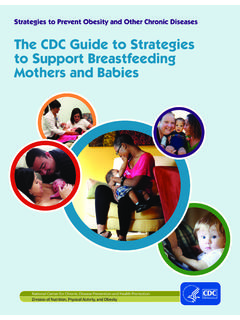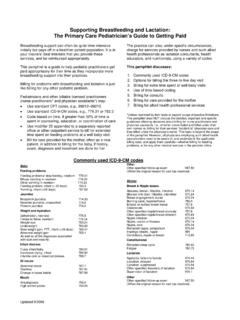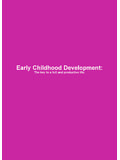Transcription of Infant and Young Child Feeding - UNICEF
1 Programming Guide Infant and Young Child Feeding June 2012 Nutrition Section, Programmes, UNICEF New York ii Cover photos (clockwise from top left): Zambia: UNICEF /NYHQ2010-0847/Christine Nesbitt Cuba: Edin Pop Laos: UNICEF /LaoPDR00284/Jim Holmes Bangladesh: UNICEF /NYHQ2006-2693/Shehzad Noorani Mali UNICEF /NYHQ2009-1913/Giacomo Pirozzi Sudan: UNICEF /NYHQ2009-1476/Kate Holt Turkey: UNICEF /NYHQ2005-1222/Roger LeMoyne United Nations Children s Fund ( UNICEF ) June 2012 Permission to reproduce or extract any part of this document is required. This is a working document. Any comments or corrigenda to this version and requests to reproduce may be sent to: the IYCF Unit, Nutrition Section, UNICEF New York, at: iii Acknowledgements This programming guide was prepared by Dr. Nune Mangasaryan, Senior Nutrition Advisor, Christiane Rudert, Nutrition Specialist ( Infant Feeding ), Edith Cheung, Nutrition Specialist (Complementary Feeding ), Dr.
2 Mandana Arabi (formerly Complementary Feeding Specialist), and David Clark, Nutrition Specialist (Legal), from the Infant and Young Child Feeding Unit, Nutrition Section, Programmes, UNICEF New York, with the support of Werner Schultink, Chief of Nutrition Section. The inputs provided by the following people are acknowledged: Paula Claycomb, Communication for Development, France Begin, Regional Nutrition Advisor APSCC, Maaike Arts, Nutrition Specialist in Mozambique, Dr. Anirban Chatterjee, former Nutrition Specialist HIV Care and Support UNICEF New York. Editing support was provided by Linda Sanei and Crystal Karakochuk, NETI Programme Nutrition Specialist. As a working document, the Programme Guidance will periodically undergo revisions to improve its programmatic utility. Comments and suggestions are welcome from UNICEF staff and partners. For questions arising from this document or general questions on IYCF programming, contact the IYCN Unit: For specific questions regarding breastfeeding programming and HIV and Infant Feeding please contact Christiane Rudert For questions regarding complementary Feeding programming, please contact Edith Cheung For questions regarding the Code and other legal aspects of IYCF programming, please contact David Clark questions on communication to promote behaviour and social change, please contact Paula Claycomb For general comments or questions on IYCF programming or any other topics not mentioned above, please contact Nune Mangasaryan, This document can be downloaded from the UNICEF Intranet website.
3 Iv Preamble This Programme Guidance contains detailed programming information on IYCF, including breastfeeding , complementary Feeding and Infant Feeding in general and in especially difficult circumstances including in the context of HIV and in emergencies. It also briefly addresses maternal nutrition. The key action areas for these components are detailed at the different levels, including national policy/strategy level, health services, and community. The document provides strategic programme recommendations for priority IYCF actions and their operationalization that will support achievement of MDGs 1 and 4, among others, as well as UNICEF Medium Term Strategic Plan (MTSP) Focus Area 1 on Young Child Survival, Growth and Development. The document emphasizes that breastfeeding and complementary Feeding both play a significant role in the reduction undernutrition (both stunting and wasting) which is a key strategic area of UNICEF s equity focus.
4 The document briefly summarizes UNICEF s role in IYCF programming, but the document is not focused on UNICEF actions alone it may be used by a broad range of partners involved in IYCF programming. The Programme Guidance serves as a single reference on IYCF programming updating existing guidance where necessary ( HIV and Infant feeding1 and the Code2) and adding new or more detailed guidance where little existed previously ( complementary Feeding , community-based programming and communication). It draws upon and builds on existing tools such as the 2007 WHO/ UNICEF Planning Guide for National Implementation of the Global Strategy for IYCF, with additional detailed and practical guidance on the how the design and implementation of the recommended key IYCF action areas at scale in a comprehensive manner. For each component, the document describes the best practices, based on lessons learned, case studies, reviews and evidence of impact.
5 It suggests options to implement proven effective interventions, such as institutionalizing the BFHI, building skills of community health workers to counsel and support mothers on IYCF and describing improved approaches to communication for behaviour and social change. The guidance highlights that communication alone is not sufficient for improving breastfeeding and complementary Feeding practices, and needs to be complemented by counselling and support by skilled workers at community and health system levels. The new guidance on complementary Feeding programming includes the process and tools for assessment of various parameters to understand the local complementary Feeding situation, a decision tree on selecting appropriate programmatic options depending on the local situation and the use of different types of products within complementary Feeding programmes. Annex 1: Resources, tools & useful websites contains a listing with active web links of major reference materials, tools and resources on IYCF to facilitate the planning and implementation process.
6 The Programming Guide aims to be comprehensive. However, users may elect to use only those chapters, resources and tools that provide the direction they are seeking on a specific topic. The potential for modular use of the guidance is the reason why there is a certain amount of repetition in the document. This document may be used to help design and implement comprehensive IYCF programmes, but also to assess the extent to which existing programmes are congruent with the recommended key action areas. The associated IYCF Assessment Matrix (Resources Annex 1-1) is to be used to provide a detailed overview of the scope and scale of all of the action areas in each country. This overview will serve as a baseline, and after a certain number of years the matrix can be updated to assess the progress in each country with the various programme components. Finally, UNICEF has also recently developed a number of new tools for IYCF: a complete generic training package and planning/adaptation guide for community based IYCF counselling; a set of training slides and resource module on communication on exclusive breastfeeding (currently being conveyed through webinars but can be used in the field too) and an e-learning course for programme managers and technical staff on IYCF, currently under development in collaboration with Cornell University.
7 A slide set on the programme guidance can be used to promote and advocate for increased attention to IYCF or to orient stakeholders on the key IYCF action areas. 1 UNICEF , CF/PD/PRO/2002-03: Infant Feeding and Mother to Child Transmission of HIV 2 UNICEF , CF/PD/PRO/2000-03: Implementation of the International Code of Marketing of Breast Milk Substitutes v Table of Contents ACKNOWLEDGEMENTS .. III PREAMBLE .. IV LIST OF ABBREVIATIONS .. VII EXECUTIVE SUMMARY: KEY POINTS .. 1 1. BACKGROUND .. 2 INTRODUCTION .. 2 IYCF AND ITS ROLE IN Child SURVIVAL, GROWTH AND DEVELOPMENT .. 3 SUMMARY OF GLOBAL SITUATION .. 10 THE POLICY BASES FOR IYCF .. 14 SUMMARY OF THE EVIDENCE ON EFFECTIVE OF INTERVENTIONS .. 15 2. NATIONAL LEVEL STRATEGIC PLANNING FOR IYCF .. 17 ADVOCACY, PARTNERSHIPS AND COORDINATION .. 18 Advocacy and partnerships .. 18 19 SITUATION ASSESSMENT .. 21 Completing assessment matrix.
8 21 Obtaining baseline of practices using the updated IYCF indicators .. 22 Reviewing the area graphs for the country .. 24 Collecting additional quantitative & qualitative data .. 25 DEVELOPING NATIONAL IYCF POLICY .. 27 National IYCF 27 Policies for strengthening IYCF within health systems .. 28 Policies to strengthen IYCF within community-based services .. 29 DEVELOPING A COMPREHENSIVE IYCF STRATEGY & PRIORITIZING INTERVENTIONS .. 30 Goals, objectives and targets of the national IYCF strategy .. 31 Costing of the strategy .. 32 Key components and interventions of IYCF strategy .. 32 Strategy component: Legislation .. 33 Strategy component: Interventions in the health system .. 35 Strategy component: Community based IYCF interventions .. 37 Strategy component: Communication for behaviour and social change .. 38 Strategy component: Additional complementary Feeding interventions/components .. 39 Strategy component: IYCF in exceptionally difficult circumstances.
9 43 Prioritizing interventions .. 45 Prioritizing interventions to protect, promote, and support breastfeeding .. 45 Prioritizing and selecting interventions to improve complementary Feeding : Decision Tree .. 46 USING ADDITIONAL OPPORTUNITIES FOR INTEGRATION OF IYCF .. 51 DEVELOPING NATIONAL & SUB-NATIONAL IYCF PLANS OF ACTION AND MOBILIZING RESOURCES .. 52 Developing national & sub-national plans .. 53 Mobilizing resources and partners .. 55 IMPLEMENTING, MONITORING, REVIEWING AND EVALUATING .. 56 3. ACTION AREAS FOR IYCF IMPLEMENTATION .. 62 REGULATORY ACTIONS .. 62 Implementation of national legislation on marketing of BMS (Code) .. 62 Implementation of maternity protection and workplace BF policies .. 63 HEALTH SERVICE LEVEL ACTIONS .. 64 IYCF counselling and support skills in pre-service and in-service training curricula .. 64 Capacity building of health providers in IYCF counselling .. 65 Infant Feeding counselling and support in health services.
10 67 Institutionalization of the 10 Steps to Successful breastfeeding .. 70 Group education & communication in the health services .. 72 vi Strengthening complementary Feeding : supplementation in the health system .. 73 Counselling and support in the health system on maternal nutrition during pregnancy and lactation .. 74 COMMUNITY LEVEL ACTIONS .. 75 Assessment, design & planning of community-based IYCF .. 76 Building capacity for and implementing community IYCF counselling .. 81 Mother-to-mother support .. 84 Supportive supervision, monitoring and evaluation .. 87 COMMUNICATION .. 89 Establishment of national communication coordination mechanism .. 90 Undertaking a communication situation assessment and analysis .. 90 Development of a communication strategy and operational plan .. 93 Design of messages and materials and selection of channels .. 98 Implementation of the communication strategy .. 101 Monitoring and evaluation of the effect of communication on behaviour.

















